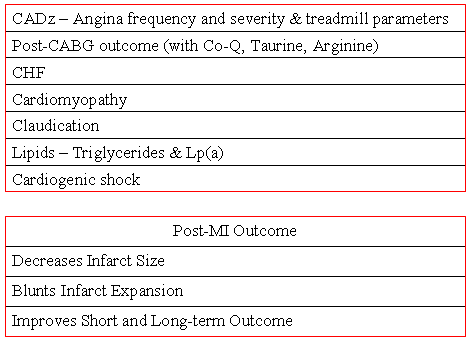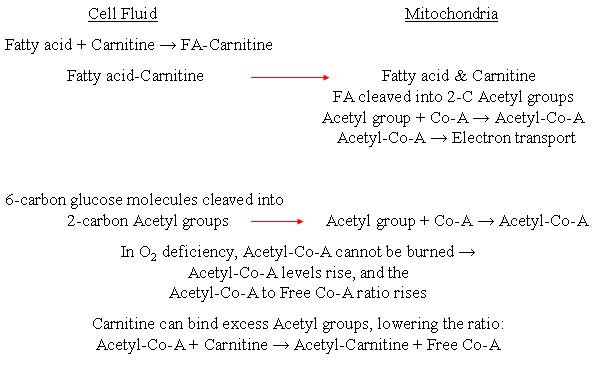
Return to Bioenergetic Support Page
Carnitine Overview
Like CoQ10, carnitine has been shown to be of value in nearly all cardiovascular conditions, as outlined below. This makes sense, as cardiac disease is due to cardiac energy deficiency, and carnitine improves energy metabolism.

Carnitine is critical to energy metabolism. First, carnitine is used to ferry fatty acids from the cell fluid in to the mitochondria. Second, carnitine can maintain high yield, oxygen dependent fatty acid metabolism, delaying the switch to low yield, oxygen independent metabolism of glucose. This is why the carnitine supplemented patient with coronary disease can walk one minute longer on the treadmill.
There are three routes through which our cells can generate ATP energy:
1. Aerobic glucose metabolism (preferred by the brain). Here, in an oxygen dependent fashion, one six carbon glucose molecule is burned to generate 36 ATP molecules:
![]()
2. Anaerobic glucose metabolism - glucose is fermented, in an oxygen independent process, to produce 2 ATP molecules. Anaerobic glycolysis is designed to be an emergency back up energy source, to keep us from dying instantly if we are temporarily deprived of oxygen (we fall in to a lake and it takes a little time to rise up to the surface) or if we temporarily need more oxygen than even a healthy circulation can provide (sprinting to get away from a saber tooth tiger). We switch from aerobic to anaerobic glucose metabolism when the cell "sees" a low oxygen level; the actual "switch" is a rise in the acetyl-CoA to free CoA ratio.
![]()
3. Aerobic fatty acid metabolism (preferred by the heart and exercising muscles). Fatty acids can be burned only in the presence of oxygen, but yield copious amounts of ATP energy:
![]()
Now let's review energy metabolism, using the diagram below:
 Fat from our
diet is broken down in the cell fluid in to individual, long chain fatty acids,
but fatty acids can only be burned within the mitochondria, the "power house"
organelles within the cell. Carnitine is needed to ferry fatty acids from
the cell fluid into the mitochondria. Carnitine binds to a fatty acid in
the cell fluid, the carnitine-fatty acid complex is then transported into the
mitochondria, the fatty acid is released, and free carnitine then crosses back
into the cell fluid to ferry another fatty acid into the mitochondria for
burning - this is the "carnitine shuttle". Once in the mitochondria the
long chain fatty acid is broken down into two carbon fragments (acetyl groups).
The two carbon acetyl group then binds to free Co-A to form acetyl-Co-A, which
enters the Citric Acid Cycle, in which electrons are stripped from the carbon
atoms. The electrons are transported within the Electron Transport Chain,
and this energy is later used to bind phosphorus to ADP to form ATP. The
six carbon glucose molecule is split in the cell fluid in to two carbon acetyl
groups, which also bind to free Co-A, to form acetyl-Co-A, which then enters the
Citric Acid Cycle.
Fat from our
diet is broken down in the cell fluid in to individual, long chain fatty acids,
but fatty acids can only be burned within the mitochondria, the "power house"
organelles within the cell. Carnitine is needed to ferry fatty acids from
the cell fluid into the mitochondria. Carnitine binds to a fatty acid in
the cell fluid, the carnitine-fatty acid complex is then transported into the
mitochondria, the fatty acid is released, and free carnitine then crosses back
into the cell fluid to ferry another fatty acid into the mitochondria for
burning - this is the "carnitine shuttle". Once in the mitochondria the
long chain fatty acid is broken down into two carbon fragments (acetyl groups).
The two carbon acetyl group then binds to free Co-A to form acetyl-Co-A, which
enters the Citric Acid Cycle, in which electrons are stripped from the carbon
atoms. The electrons are transported within the Electron Transport Chain,
and this energy is later used to bind phosphorus to ADP to form ATP. The
six carbon glucose molecule is split in the cell fluid in to two carbon acetyl
groups, which also bind to free Co-A, to form acetyl-Co-A, which then enters the
Citric Acid Cycle.
During healthy, oxygen utilizing metabolism, carnitine is needed to bring fatty acids into the mitochondria for processing. Carnitine serves another role when oxygen is in short supply, of critical importance to the patient with coronary disease of CHF. We have enzyme systems that mediate the high yield, oxygen dependent metabolism of glucose, and we have a second set of enzymes that mediate the low yield, oxygen independent fermentation of glucose. Mother Nature always strives for economy, so when oxygen is plentiful, the fermentation enzymes are inactive and the oxidative enzymes are functional. When oxygen is absent, or in short supply, it doesn't make sense for the oxygen dependent enzymes to remain active. They can't accomplish anything as no oxygen is available, so why waste the precious few ATP molecules that the cell has left to run them? The aerobic enzymes need to be "turned off", and the switch that turns them off is a rising acetyl-Co-A to free Co-A ratio. The metabolic step most sensitive to low oxygen is the entry of acetyl-Co-A into the Citric Acid Cycle. When oxygen deficiency blocks entry of acetyl-Co-A into the Citric Acid Cycle, acetyl-Co-A levels will build up, as will the ratio of acetyl-Co-A to free Co-A. This high acetyl-Co-A to free Co-A ratio turns off the enzymes of high yield oxygen dependent glucose metabolism, even when some oxygen is left within the cell. Mother Nature set the switch too tightly here; she shuts off aerobic metabolism even when some oxygen is available (don't blame her, as she never planned on us plugging up our arteries and being in this situation in the first place). We still have some oxygen within the cell, but we can't use it to burn sugar efficiently, because the switch has been thrown by a high acetyl-Co-A to free Co-A ratio (remember, it is not the absolute level of acetyl-Co-A, it is the acetyl-Co-A to free Co-A ratio). While all of this is going on, cellular carnitine levels are falling. As we can't burn fatty acids at all, not without sufficient oxygen, the fatty acid level within the cell begin to rise. Soon the cell is overfilled with fatty acids that it cannot burn; they leak out of the cell and damage the cell membranes of adjacent cells. Then they leak out into the circulation and cause systemic acidosis. This is a bad scenario. Carnitine tries to stem the rise and eventual spill over of fatty acids, by binding them up. Just as carnitine can bind to fatty acids to ferry them into the mitochondria, carnitine can bind to, or "buffer" the rising level of fatty acids in the oxygen deprived cell. The problem here is that this "buffering" activity ties up all of the cell's carnitine, such that it can no longer participate in energy metabolism. This cell is on its way to energy failure and cellular death; it is low in oxygen, carnitine, and because of a high acetyl-Co-A to free Co-A ratio, it cannot even burn glucose efficiently.
But what would happen if we could get some extra carnitine into this cell? First, we could buffer the rise in fatty acids; less would spill out into the circulation and there would be less systemic acidosis. Second, carnitine can bind two carbon acetyl groups, just as it binds to longer carbon chain fatty acids. If we can get enough carnitine into the mitochondria, we can lower the acetyl-Co-A level. The acetyl group in acetyl-Co-A can be transferred to carnitine to form acetyl-carnitine. Free Co-A is generated, the acetyl-Co-A to free Co-A ratio falls, the enzymes of aerobic, oxygen utilizing glucose metabolism are turned back on, and the cell can make 36 ATP molecules from glucose, as opposed to just 2. This cell will function better, actually a lot better, in this low oxygen, but not absent oxygen, environment. This will give you another minute on the treadmill during a stress test, and another few blocks when you are walking on your own. If you have heart failure, which produces a metabolic derangement that wastes carnitine, supplementation will improve your exercise capacity. If you are trying to survive a heart attack, extra carnitine on board will increase the likelihood that the cells of your heat will survive, and you will have a less extensive heart attack. Carnitine is thus of value in any cardiac condition associated with strained energy metabolism. Just as does CoQ10, carnitine provides bioenergetic support to the energy strained heart.
James C. Roberts MD FACC
1/01/07